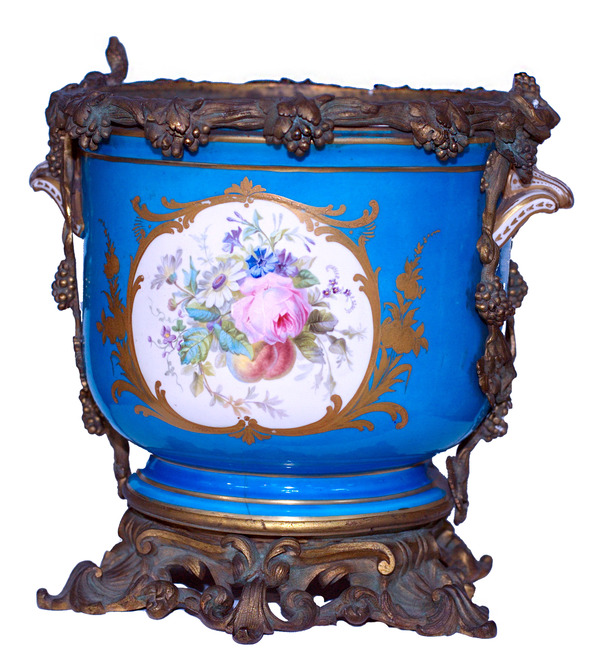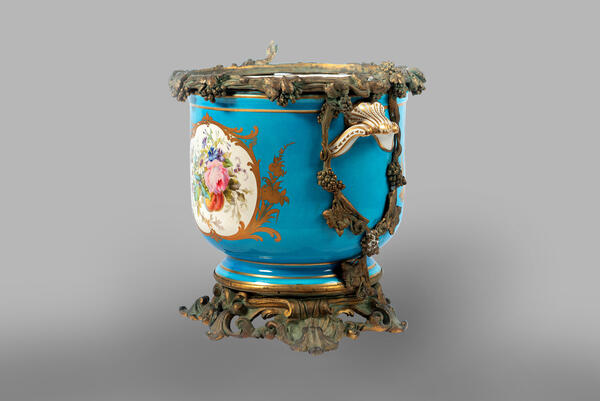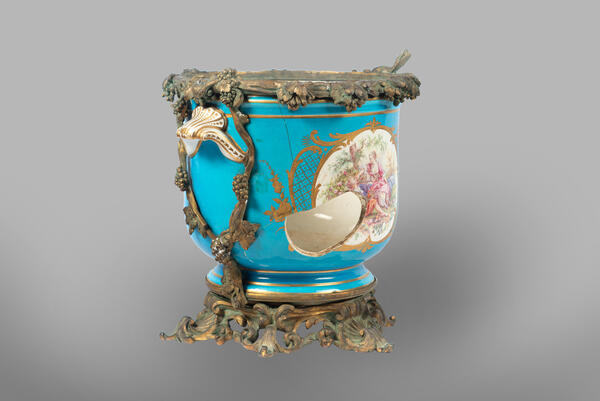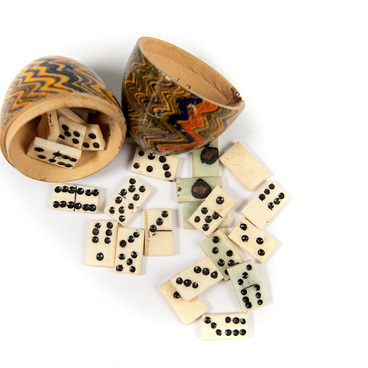The famous Sèvres sky blue background paint (bleu celeste) was created in 1753. It changes color depending on the firing temperature: when the temperature drops, it is blue; when it rises, it is closer to green.
A recurring motif in Sèvres porcelain painting was floral arrangements. The compositions used a variety of flowers: roses, including a single rose in a bouquet, and Marie-Antoinette’s favorite flower — the cornflower. Flower and fruit arrangements were widely used.
François Boucher (1703–1770) was a French painter, engraver and decorator, a prominent representative of the Rococo artistic culture. The artist worked in many types of decorative and applied art: he created sets for operas and plays, paintings for the royal tapestry factories; he executed ornamental paintings of Sèvres porcelain, painted fans and miniatures. Boucher was awarded with many honors, including the title of Court Painter. In his later years, he was director of the Royal Academy of Painting and Sculpture and “the King’s first painter”.
The tradition of decorating rooms with various plants in beautiful pots was born in ancient China. Craftsmen made original vases from clay and porcelain, decorated them with paintings and placed them in the emperor’s chambers. But such pots quickly fell into disrepair — they became moldy, the edges broke off and had to be often replaced. This affected the flowers that do not like to be replanted so often. Eventually, a new idea was born in France to hide ugly flower pots in pretty, easy-to-clean cachepots. The cachepot does not have traditional drainage holes for conventional flower pots, so plants are hardly ever planted directly into it, using the cachepot only for decorative purposes.
A Sèvres-style cachepot is a striking detail of an 18th–19th-century noble manor house. The cachepot is decorated on both sides. On one side is a pastoral scene in the style of François Boucher, on the other — a picturesque floral bouquet. The bronze parts: the base, the side frames and the upper edge frame are partially preserved in their original gilding. On the bottom of the cachepot there is a cobalt stamp of the Sèvres manufactory, possibly imitation. The porcelain cachepot has chipped damage on the porcelain part.
A recurring motif in Sèvres porcelain painting was floral arrangements. The compositions used a variety of flowers: roses, including a single rose in a bouquet, and Marie-Antoinette’s favorite flower — the cornflower. Flower and fruit arrangements were widely used.
François Boucher (1703–1770) was a French painter, engraver and decorator, a prominent representative of the Rococo artistic culture. The artist worked in many types of decorative and applied art: he created sets for operas and plays, paintings for the royal tapestry factories; he executed ornamental paintings of Sèvres porcelain, painted fans and miniatures. Boucher was awarded with many honors, including the title of Court Painter. In his later years, he was director of the Royal Academy of Painting and Sculpture and “the King’s first painter”.
The tradition of decorating rooms with various plants in beautiful pots was born in ancient China. Craftsmen made original vases from clay and porcelain, decorated them with paintings and placed them in the emperor’s chambers. But such pots quickly fell into disrepair — they became moldy, the edges broke off and had to be often replaced. This affected the flowers that do not like to be replanted so often. Eventually, a new idea was born in France to hide ugly flower pots in pretty, easy-to-clean cachepots. The cachepot does not have traditional drainage holes for conventional flower pots, so plants are hardly ever planted directly into it, using the cachepot only for decorative purposes.
A Sèvres-style cachepot is a striking detail of an 18th–19th-century noble manor house. The cachepot is decorated on both sides. On one side is a pastoral scene in the style of François Boucher, on the other — a picturesque floral bouquet. The bronze parts: the base, the side frames and the upper edge frame are partially preserved in their original gilding. On the bottom of the cachepot there is a cobalt stamp of the Sèvres manufactory, possibly imitation. The porcelain cachepot has chipped damage on the porcelain part.






